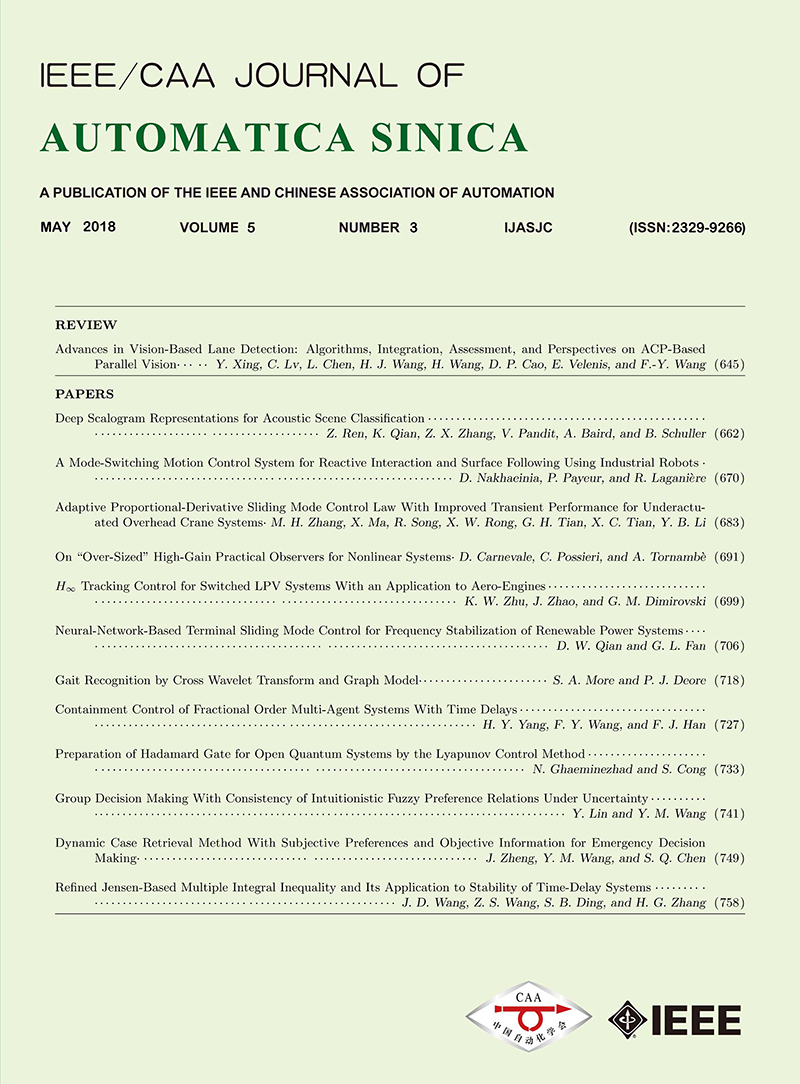 Volume 2
Issue 1
Volume 2
Issue 1
IEEE/CAA Journal of Automatica Sinica
| Citation: | Shuochen Liu, Zhiyong Geng and Junyong Sun, "Finite-time Attitude Control: A Finite-time Passivity Approach," IEEE/CAA J. of Autom. Sinica, vol. 2, no. 1, pp. 102-108, 2015. |

| [1] |
Akella M R. Rigid body attitude tracking without angular velocity feedback. System and Control Letter, 2001, 42(4):321-326
|
| [2] |
Luo W, Chu Y, Ling K V. Inverse optimal adaptive control for attitude tracking of spacecraft. IEEE Transactions on Automatic Control, 2005, 50(11):1639-1654
|
| [3] |
Mayhew C G, Sanfelice R G, Teel A R. Quaternion-based hybrid control for robust global attitude tracking. IEEE Transactions on Automatic Control, 2011, 56(11):2555-2566
|
| [4] |
Schlanbusch R, Loria A, Kristiansen R, Nicklasson P J. PD+ based output feedback attitude control of rigid bodies. IEEE Transactions on Automatic Control, 2012, 57(8):2146-2152
|
| [5] |
Crouch P E. Spacecraft attitude control and stabilization:applications of geometric control theory to rigid body models. IEEE Transactions on Automatic Control, 1984, 29(4):321-331
|
| [6] |
Wen J T, Kenneth K D. The attitude control problem. IEEE Transactions on Automatic Control, 1991, 36(10):1148-1162
|
| [7] |
Egeland O, Godhavn J M. Passivity-based adaptive attitude control of a rigid spacecraft. IEEE Transactions on Automatic Control, 1994, 39(10):842-846
|
| [8] |
Yu S H, Yu X H, Shirinzadeh B, Meng Z H. Continuous finite-time control for robotic manipulators with terminal sliding mode. Automatica, 2005, 41(11):1957-1964
|
| [9] |
Jin E, Zhao S. Robust controllers design with finite time convergence for rigid spacecraft attitude tracking control. Aerospace Science Technology, 2008, 12(4):324-330
|
| [10] |
Du H, Li S, Qian C. Finite-time attitude tracking control of spacecraft with application to attitude synchronization. IEEE Transactions on Automatic Control, 2011, 56(11):2711-2717
|
| [11] |
Meng Z Y, Ren W, You Z. Distributed finite-time attitude containment control for multiple rigid bodies. Automatica, 2010, 46(12):2092-2099
|
| [12] |
Scharf D P, Hadeagh F Y, Ploen S R. A survey of spacecraft formation flying guidance and control (Part II):Control. In:Proceedings of the 2004 American Control Conference. Boston, USA:IEEE, 2004. 2976-2985
|
| [13] |
Lizarralde F,Wen J T. Attitude control without angular velocity measurement:a passivity approach. IEEE Transactions on Automatic Control, 1996, 41(3):468-472
|
| [14] |
Tsiotras P. Stabilization and optimality results for the attitude control problem. Journal of Guidance, Control, and Dynamics, 1996, 19(4):772-779
|
| [15] |
Tsiotras P. Further passivity results for the attitude control problem. IEEE Transactions on Automatic Control, 1998, 43(11):1597-1600
|
| [16] |
Tayebi A. Unit quaternion based output feedback for the attitude tracking problem. IEEE Transactions on Automatic Control, 2008, 53(6):1516-1520
|
| [17] |
Ren W. Distributed cooperative attitude synchronization and tracking for multiple rigid bodies. IEEE Transactions on Control Systems Technology, 2010, 18(2):383-392
|
| [18] |
Shuster M D. Survey of attitude representations. The Journal of the Astronautical Science, 1993, 41(4):439-517
|
| [19] |
Khalil H K. Nonlinear Systems (Third Edition). Jersey:Prentice Hall, 2002.
|
| [20] |
Bhat S, Bernstein D. Finite-time stability of continuous autonomous systems. SIAM Journal on Control and Optimization, 2000, 38(3):751-766
|
| [21] |
Hardy G, Littlewood J, Polya G. Inequalities. Cambridge, UK:Cambridge University Press, 1952.
|